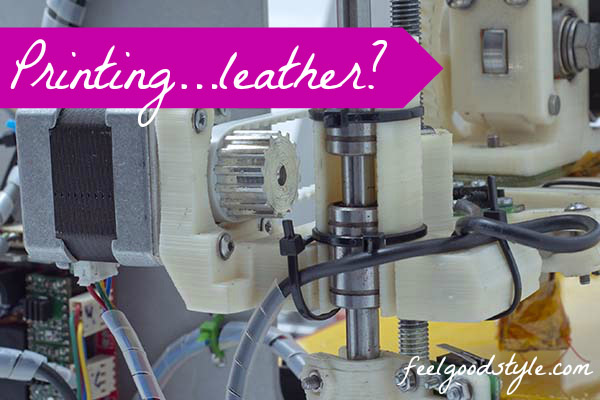Could 3D printed leather produce cruelty-free faux leather goods?
Andras Forgacs developed a method of 3D printing that could produce human body parts and organs for medical purposes. Now he’s working to use that same techbology to create animal products without the animals, including faux leather.
The Trouble with Leather
Leather – like all animal-derived products – comes with a dash of animal cruelty.
I’ve heard the argument that since leather is a by-product of the meat industry, it actually reduces waste to consume it. In fact, the leather industry helps support the meat industry, because leather sales are an additional income source for farmers raising cattle for slaughter, it’s not just picking up the slack. According to Keegan K. at Care2:
It is estimated that leather makes up half of all profits of slaughterhouses that process cattle. Leather is a not a by-product, it is a co-product.
Because the profit margin is rather small on the sale of animal flesh (relatively speaking), most cattle exploiting companies are dependent upon the sale of hides to remain in business.
When dairy cows reach the end of their milk-producing years, they are also slaughtered and turned into leather goods, which is why dairy is just as bad for animals as meat. They produce the milk while they’re alive, but once they’re beyond usefulness, they’re sent to slaughter.
Beyond Cruelty: Leather’s Eco Impact
Even if these animal deaths don’t bother you, there’s the environmental impact of raising all of these cows.
Forgacs estimates that it takes 100 billion cattle to satisfy our tastes for meat and leather by 2050, and that is going to wreak havoc on our air, water, and land. For example, nearly 70 percent of Amazon deforestation is due to cattle farming.
3D Printed Faux Leather Goods
In this interesting TED Talk, scientist Andras Forgacs talks about the trouble with the leather and meat industries and explains how he’s working to produce faux leather and meat with 3D printing technology:
From a vegan standpoint, this technology is still a little bit dicey. You still start with animal cells, which means that this faux leather product is not vegan. But! It would certainly be better for animals and for the environment than the way industry produces leather goods now. If we can’t convince consumers to ditch the leather, this could be a best second option, saving hundreds of billions of animals’s lives.
Also – as Forgacs points out – the biopsy process that they use to get those cells doesn’t harm the animal. My main questions would be: how would these animals live, and what happens when they’re no longer useful for biopsies?
What do you guys think about 3D printed leather? If you’re vegan, would you wear this faux leather?
Image Credit: 3D printer photo via Shutterstock


